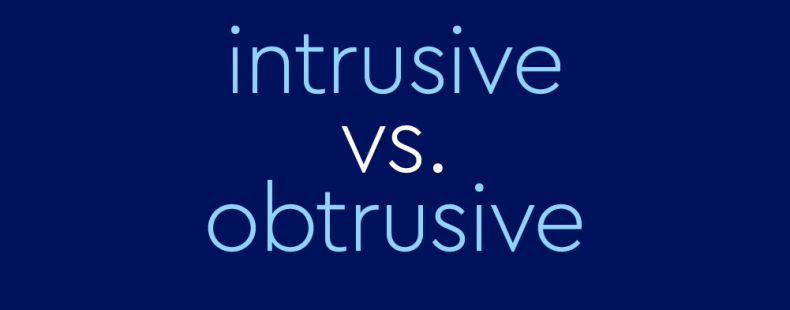Imagine this: one day, you look out your window and notice that the neighbors have installed a very large shed in their yard. If this shed blocks a view you previously enjoyed, would you describe it as intrusive or obtrusive?
It’s natural to wonder. Intrusive and obtrusive both refer to something or someone who invades or is thrust into a situation in an unwelcome way. And the shed that wasn’t there the day before is definitely an unwelcome invader—at least to you.
The meanings and sounds of both intrusive and obtrusive are close enough that it can be easy to confuse them. So let’s look a little closer at these two words.
How are intrusive and obtrusive alike?
Intrusive and obtrusive have very similar meanings. They both involve inserting oneself into a situation, especially without being welcomed or invited. They’re both adjectives that describe behaviors, people, or things.
Both words share a common Latin root. The ending -trude originally came from the Latin trudere. This word means “to thrust,” which relates to the meanings of both intrusive and obtrusive.
How is intrusive different from obtrusive?
While some thesauruses present the words as synonyms, there are a few subtle distinctions between them.
How do you use intrusive?
Intrusive is much more common that obtrusive. Intrusive, as it is frequently used, can refer to internal, personal intrusions. A person can have intrusive thoughts. Questions can be intrusive. Here is one example:
- “Citizens who accept positions in government that give them access to sensitive information—myself included, when I went to work for the White House in 2005—are asked highly intrusive questions about marriage and adultery.” (Wall Street Journal)
A person can also be intrusive: Lily is very intrusive, as she’s always trying to insert herself in other people’s conversations. A baby’s birth is one occasion where people might be considered intrusive:
- “Your partner should probably be there. … [And] maybe one friend or family member who can fade into the background or be helpful and supportive without being intrusive.”(Midwifery Today)
Those who are intrusive aren’t always trying to get attention. They may interfere in others’ affairs by accident. Let’s say Lily goes into the living room to relax, only to find Jon and Jasmine having a private conservation in there. In this case she’s being intrusive because she’s unintentionally invading something she isn’t meant to be a part of.
How do you use obtrusive?
Being obtrusive means being much bolder with the interference. So let’s say Lily knows that Jon and Jasmine are talking in the other room and barges in wanting to know what is going on. In this case she’s obtrusive because she’s intentionally invading something she’s not meant to be a part of. At the same time, someone who constantly corrects another in a conversation is being obtrusive. They are intentionally interrupting someone else with comments.
Also, obtrusive is often used to describe a physical interference. For example, a billboard near a person’s home or the highway can be obtrusive. (And it would not be described as intrusive.) This also means the shed in our first example is considered obtrusive.
Examples using intrusive and obtrusive
Here are several examples:
- “If it had not been for an intrusive Supreme Court, citizens would not have had an equal right to vote. If it had not been for persistent and brave lawyers, bosses like Joe Hurst would have continued to get away with stuffing ballot boxes and sending the graveyard in to vote.” (Washington Monthly)
- “Other innkeepers view the very notion of regulation as intrusive, says Bobbi Zane, who reviews inns for Fodors travel guides and publishes an industry newsletter called Yellow Brick Road.” (Associated Press)
- “The chief reason we have failed to take account of the unifying components of cathedral and chapel is the glass partition inserted between them in the nineteenth century. This obtrusive addition has drastically changed our experience of the ensemble and undermined analysis of the design …” (ACAD: Art Bulletin)
- “They relocated the bobsled and luge track to a less obtrusive location in an evergreen forest.” (Atlanta Journal-Constitution)
Not to be intrusive, but we heard you might be interested in clearing up the confusion over other befuddling word pairs. Check out our articles on ambiguous vs. ambivalent, affect vs. effect, and race vs. ethnicity.














